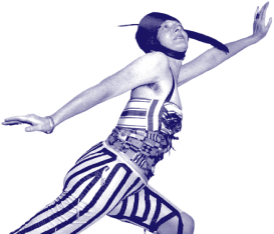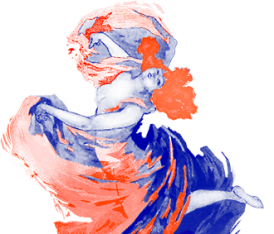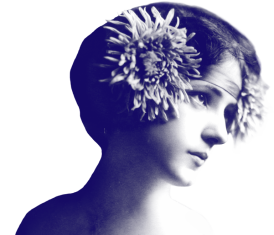HomeNews & Events2007November Peter Goddard Interviews Dr. Gammel
The Perils of Baroness Elsa
Peter Goddard
Toronto Star. Toronto, Ont.: May 12, 2005. pg. G.01
What: Dada Live book launch and performances
Where: Hard Rock Cafe, 279 Yonge St.
When: Wednesday @ 4 30 p.m.
Whirlwind in-your-face performance artist of the early 20th century gets fresh attention.
Ryerson University and the Hard Rock Cafe at 279 Yonge St. have maintained an uneasy relationship for years. Each establishment has felt that its regulars have been spending far too much time in the other, not accomplishing anything of note while doing so.
There'll be at least one night of rapprochement next Wednesday when the Cafe hosts the launch of a pair of books devoted to one of the great characters, sexual adventurers and survivors in the 20th century, Baroness Elsa von Freytag-Lorinhoven.
Putting the appropriate Hard Rock Cafe spin on Baroness Elsa, who died in 1927, she is described as “Dadaist, Proto-Punk, Poet.” She would have agreed, adding still more descriptions, such as sculptor, painter, model, actress and muse.
Elsa would have loved this kind of night, too, as she demanded nothing less than complete attention. However, I doubt if she would have found much in common with a venue devoted to formulaic head- banging pop music. The only rules or formulas the Baroness liked were the ones she could break.
The books being launched are, I got lusting palate/ Mein Mund ist lustern, a slim collection of the Baroness's Dada-ist sound poetry edited by Irene Gammel, of Ryerson's modern literature and culture department; and Holy Skirts, Rene Steinke's novel about the Baroness's New York days, where she was the doyenne of The Little Review, an avant-garde journal that liked to think it was the magazine read by people who put out all the other magazines. The novel covers some of the same turf found in Baroness Elsa, Gammel's 2002 biography.
Dada Live, as Wednesday's event is being called, will also feature someone dressed like the Baroness would have been, although she would never have called it “a costume,” as does Ryerson.
(Someone will also read from the Baroness's poetry).
Elsa's clothes - she was huge on parrot feathers for a while - were part of what she wanted to express, not something behind which to hide.
Not the least of the Baroness's many achievements - and our Canadian connection - came when she seduced the pants off Felix Paul Greve in 1902. She so sexually dazzled the young, handsome and ostensibly gay German translator of Oscar Wilde that he soon found his inner Canadian heterosexual, moved to Manitoba to teach school and changed his name to Frederick Philip Grove, as he remains known in most Canadian literary histories.
Most Canadians think of F.P. Grove in terms of the tough-minded pioneering figures you find in works such as Fruits of the Earth (1933), sort of early, literary Ian Tyson. But it was Grove's affair with Elsa, recounted in a heavily fictionalized Governor General Award-winning autobiography, In Search of Myself (1946), that really spun his life around.
His “overpowering” sexual encounter with Elsa (renamed Mrs. Broegler), Grove writes, “saved” him from becoming “involved” with homosexuality, “in any sense whatsoever. If I had not always been so, I had become definitely, finally heterosexual.”
Irene Gammel's own research into Grove for her PhD thesis led her to Else Hildegard Plotz, as the Baroness was born July 12, 1874 on Germany's Baltic coast.
“I came to discover, through her writing, her plays with words, that she was decades ahead of her time,” says Gammel. “Her life story also had that fascination. We have to see her within that modernist era. It was all about overcoming Victorianism that was so associated with sexual repression and etiquette. It was about pushing against these boundaries.
“And it must be remembered that the censorship in the teens and '20s was very, very powerful. But she was driven. With her it was all about emotion and she was driven toward independence.”
Alternatively fascinated and horrified by her dominating father, Adolf, Elsa eventually fled to Berlin to escape him.
“Her father was a charismatic figure,” says Gammel who draws a parallel between Herr Plotz and the hyper-masculine, dominant figure of German chancellor Otto von Bismarck. “He impressed her yet at the same time he was the abuser in the family. He beat his wife, and the children, although there is no evidence of sexual abuse. She was a very strong person.”
Careers as a model, actress and as wife to three men - second husband Grove was practically handed to her on a plate by first husband August Endell, a young architect - eventually leads her to America and third husband Baron Leopold von Freytag-Loringhoven, whom she married in 1913, the year after Grove had settled in Manitoba. The Baron, who returned to Europe, committed suicide in 1919.
But any attempt to make chronological sense of the Baroness's sexual bildungsroman is like reviewing classical ballet as an Olympic sprint. The Baroness lived life in several directions at once, with no one goal line in sight but pleasure.
“If you included every single adventure, she'd seem like Pippi Longstockings,” says novelist Steinke who, for Holy Skirts, focused on the Baroness's poetic output during her New York days.
Distilling Gammel's already abbreviated chronology over just a few early years reveals a level of sensual swashbuckling few others could manage during a lifetime 1894 - models, first sex binge, first contracts gonorrhoea. 1895 - works as chorus girl, has lesbian experience. 1896 - hospitalized with syphilis, has affair with playwright Ernst Hardt. 1898 - elopes with Hardt's friend, sculptor Richard Schmitz, has affair with Schmitz's brother and gets involved in an early Dada porno event.
Even after you've taken all the fast turns on this libidinous roller-coaster ride, you nevertheless still find your breath nearly taken away when you read about how her '07 marriage to Greve was followed by her nervous breakdown in 1908 and his attempted suicide a year later.
Next? Well, there always was a next with her. She and Greve/ Grove go their separate ways to America only to meet again - in 1911 Sparta, Ky., before she ends up in New York five years later.
“She was always the agent of her own fate,” says Gammel. “She had an aggressive, almost masculine way of taking charge in the way she conquered men and in the number of male partners that she had. Later in life, when men ignored her, she turned to women.
“What's important is how it entered her art. Her modelling career, first in Germany then in America, became a proto performance art. When she adorned her body with sculptures, she called it art.
Her wearing of tomato cans (as a bra) predates Andy Warhol by decades. She found the first “found objects” decades before Marcel Duchamp.
“And she did not showcase this in a subculture, but walked around in these costumes on Park Ave. in New York, and on Fifth Ave. She was in your face with it.”
One neat scene in Holy Skirts ties together the Baroness's art activities with her social proclivities. Preparing to go to a fashionable New York party, she stands waiting with a postage stamp affixed to her face, a modernist beauty mark.
“Where do you expect to be mailed to?” said Sara (her escort).
“Heaven.”
The simplest encounter with Baroness Elsa provided more drama than could be found on all of Broadway. The Little Review editor Margaret Anderson noted Elsa's arrival at her offices on May 1918
“She wore high white spats with a band of decorative furniture braid around the top. Hanging from her bust were two tea balls from which the nickel had worn away. On her head was a black velvet tam o'shanter with a feather and several spoons - long ice-cream-soda spoons. She had enormous earrings of tarnished silver and on her hands were many rings, on the little finger high peasant buttons filled with shot. Her hair was the colour of a bay horse.”
Of all the events in her life, the one she probably would have wanted to redo with a lot more flair was her death, on a chilly December day in Paris, when she accidentally - or not, as she had written suicidal letters years before - left on the gas jets in her apartment.
For the Baroness's obituary, Djuna Barnes, who'd protected Elsa, wrote that her death was “a stupid joke that had not even the decency of maliciousness.”












